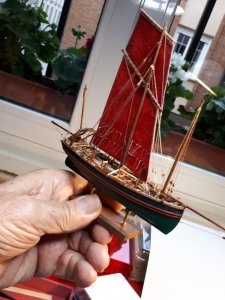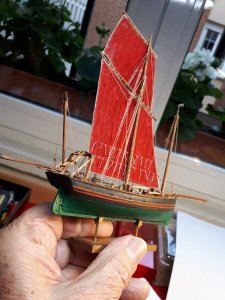The red color of the sails will fit very good - your boat will be a beauty
-

Win a Free Custom Engraved Brass Coin!!!
As a way to introduce our brass coins to the community, we will raffle off a free coin during the month of August. Follow link ABOVE for instructions for entering.
-

PRE-ORDER SHIPS IN SCALE TODAY!
The beloved Ships in Scale Magazine is back and charting a new course for 2026!
Discover new skills, new techniques, and new inspirations in every issue.
NOTE THAT OUR FIRST ISSUE WILL BE JAN/FEB 2026
You are using an out of date browser. It may not display this or other websites correctly.
You should upgrade or use an alternative browser.
You should upgrade or use an alternative browser.
“Lougre harenguier” of Fécamp. Scale 1:200 [COMPLETED BUILD]
- Thread starter Javier Baron
- Start date
- Watchers 8
-
- Tags
- completed build
- Joined
- Oct 22, 2018
- Messages
- 149
- Points
- 253

..a beauty on the palm!!
Thats a beauty, great work.
- Joined
- Oct 22, 2018
- Messages
- 149
- Points
- 253

I finished the herring herring of Fécamp. Since I did not do it in the beginning, I'm going to do a bit of an introduction at the end, because, in my opinion, it still enriches a model.
Historically, herring has been of major importance in the economies of the countries bordering the North Sea and the English Channel. Herring spines were found in the Neolithic Danish necropolis, and one of the reasons for the creation of the Hansa was by and to facilitate its trade. As a food, it has played a major role because it is a cheap fish given its abundance, high in fat and protein and suitable for different preservation techniques: salting, pickling, smoking, drying, etc. ., facilitating its transport. In the Middle Ages, it even served as a means of payment.
For centuries, herring has been caught with the same fishing gear: a set of driftnets, like gillnets, which were launched in the same way until the disappearance of the fishing. the sail: the boat, in the twilight tide, as it sailed with a reduced sail and tailwind, slowly slid the net into the current, regulating under the indications of the pattern the depth to which it rested. Once the net was stretched, the boat was put in "drome" and allowed to drift slowly, staying oriented to the wind thanks to the tape that served as an aerial rudder. They then armed the "garden" on deck, the name they gave to the drawers of movable screens and castors on the bow of the mainmast, which facilitated the collection of fishing, and they rested at night. The nets were loaded at dawn and, once the fish were collected, they were stored in the corresponding creeks while the boat returned to sail to haul the product from the harbor.
Depending on the fishing location, Shetland Islands east of La Mancha, the fish was stored without further handling to be sold again or put in brine for preservation in case of delay. the arrival at the port. The North Sea and English Channel are narrow basins, with short and agitated waves, which is very tiring for a "drome" navigation, practically dry of canvas. To reduce the pitch and roll that were amplified by the high rigging, lowered the masts on the deck while pulling the nets, the largest first, and then, when paired, the foresail. To carry out this operation, these boats had guides to fly the masts in their descent, as well as a portico raised at the stern to receive the slaughtered masts leaving the deck cleared. The use of driftnets has resulted in a clasic hull, with well-filled shapes at the front and a marked water outlet at the rear, the main frame being located 2/5 of its length from the bow.
The model represents a good size lugger, with a rig with three masts, as could be found in Fécamp between 1850 and 1880, a length of about 25 m. Shortly after, during the last decades of the 19th century, the luggages were disarmed and resold for cabotage, especially in Brittany, and the construction of a new type of herringbone, ketch-dandy or dundee, was launched, with a lenght of 32 m.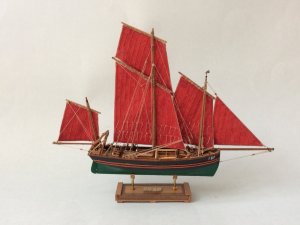
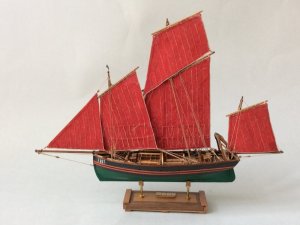
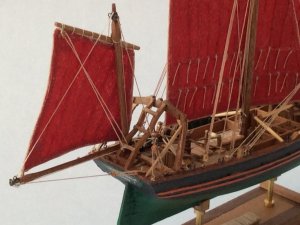
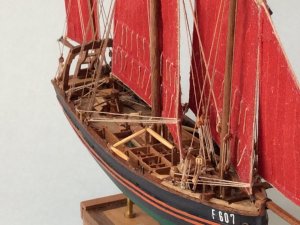
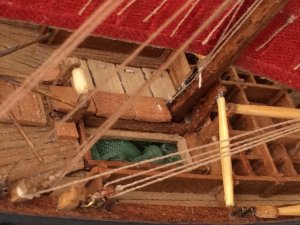
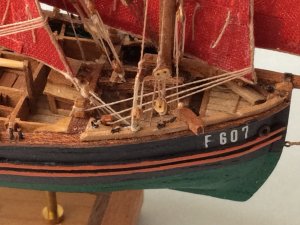
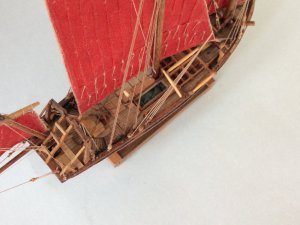
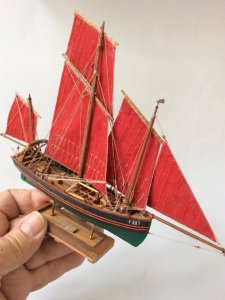
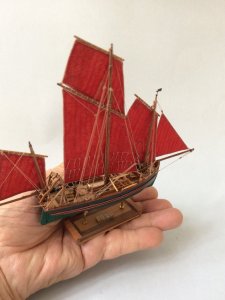
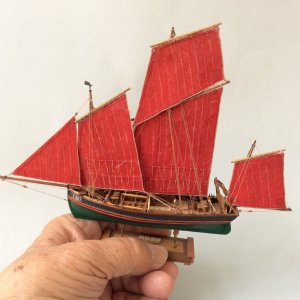










Historically, herring has been of major importance in the economies of the countries bordering the North Sea and the English Channel. Herring spines were found in the Neolithic Danish necropolis, and one of the reasons for the creation of the Hansa was by and to facilitate its trade. As a food, it has played a major role because it is a cheap fish given its abundance, high in fat and protein and suitable for different preservation techniques: salting, pickling, smoking, drying, etc. ., facilitating its transport. In the Middle Ages, it even served as a means of payment.
For centuries, herring has been caught with the same fishing gear: a set of driftnets, like gillnets, which were launched in the same way until the disappearance of the fishing. the sail: the boat, in the twilight tide, as it sailed with a reduced sail and tailwind, slowly slid the net into the current, regulating under the indications of the pattern the depth to which it rested. Once the net was stretched, the boat was put in "drome" and allowed to drift slowly, staying oriented to the wind thanks to the tape that served as an aerial rudder. They then armed the "garden" on deck, the name they gave to the drawers of movable screens and castors on the bow of the mainmast, which facilitated the collection of fishing, and they rested at night. The nets were loaded at dawn and, once the fish were collected, they were stored in the corresponding creeks while the boat returned to sail to haul the product from the harbor.
Depending on the fishing location, Shetland Islands east of La Mancha, the fish was stored without further handling to be sold again or put in brine for preservation in case of delay. the arrival at the port. The North Sea and English Channel are narrow basins, with short and agitated waves, which is very tiring for a "drome" navigation, practically dry of canvas. To reduce the pitch and roll that were amplified by the high rigging, lowered the masts on the deck while pulling the nets, the largest first, and then, when paired, the foresail. To carry out this operation, these boats had guides to fly the masts in their descent, as well as a portico raised at the stern to receive the slaughtered masts leaving the deck cleared. The use of driftnets has resulted in a clasic hull, with well-filled shapes at the front and a marked water outlet at the rear, the main frame being located 2/5 of its length from the bow.
The model represents a good size lugger, with a rig with three masts, as could be found in Fécamp between 1850 and 1880, a length of about 25 m. Shortly after, during the last decades of the 19th century, the luggages were disarmed and resold for cabotage, especially in Brittany, and the construction of a new type of herringbone, ketch-dandy or dundee, was launched, with a lenght of 32 m.




















Another great accomplishment. Congrats!  What will be your next project in miniatures?
What will be your next project in miniatures?
 What will be your next project in miniatures?
What will be your next project in miniatures?One more masterpiece - A very interesting working boat added to your collection 

Translations from Spain by Google: Hello partner and happy to greet you ... your work as always impeccable, a jewel more for the collection ... a hug LibertoHola compañero y contento de saludarte… tu trabajo como siempre impecable, una joya mas para la colección… un abrazo Liberto



